Excerpts from Jim Conrad's
Naturalist Newsletter
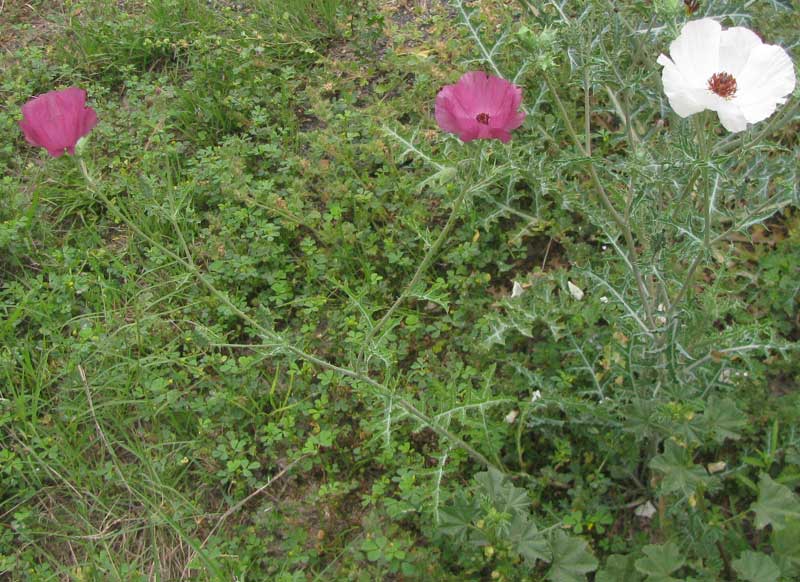
from the April 20, 2014 Newsletter issued from the Frio Canyon Nature Education Center in the valley of the Dry Frio River in northern Uvalde County, southwestern Texas, on the southern border of the Edwards Plateau; elevation ~1750m (~5750 ft); N29.62°, W99.86°; USA
RED PRICKLY POPPY
At Cook's Slough on Uvalde's south side, along a trail through the low, scrubby forest adjacent to the ponds, hundreds of knee-high prickly poppies bore large, white flowers, but occasionally one or two darkly rose-colored blossoms -- also prickly poppy flowers -- appeared among the many white heads. Above, you can see a couple of rosy ones next to a more common white blossom.
Though the rosy flowers are slightly smaller than the white one, suggesting that they are different species, the blossoms' structure is very similar, as are the leaves. Some white flowers were slightly tinged with a reddish hue, so the question arose: Were we seeing just one species with flowers ranging in color from white to rose, or were two distinct prickly poppy species mingling along the road?
To determine the matter, first a rosy blossom was looked at closely, revealing a prettiness of many dark stamens issuing from the base of a thick, stumpy ovary topped with a blunt, fuzzy, four-lobed stigma, as shown below:
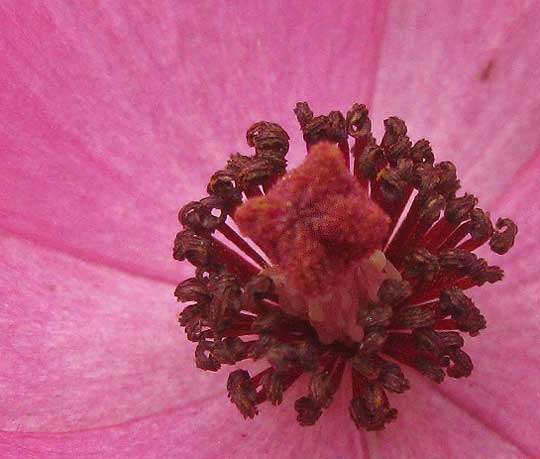
Below the 2.5-inch-wide (7cm) blossom, the rosy petals were subtended not by a typical, green, cup-like calyx, but rather by a spine-bearing, modified leaf, or bract. In the Poppy Family, to which prickly poppies belong, normally the calyx's sepals fall off as the flower matures, leaving bracts to do sepal duty. You can see all this below:
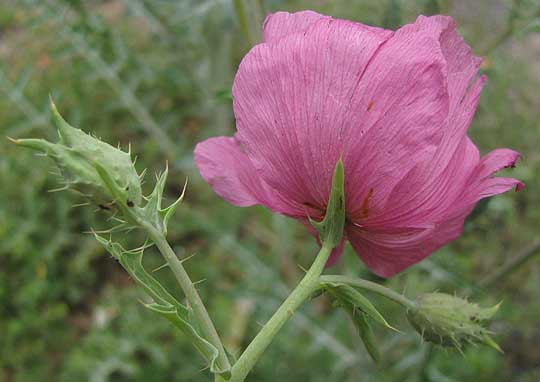
In that picture, the two spiny, pod-like items on stems beside the blossom are not fruits but rather flower buds. Each bud's spiny covering is formed by two sepals not yet split from one another and not yet fallen off.
A leaf of the plant showing its base partly growing around the stem, with spiny margins but no spines arising from veins on the blade's upper surface, and lobes with sinuses cutting more than 4/5ths of the way to the midvein is shown below:
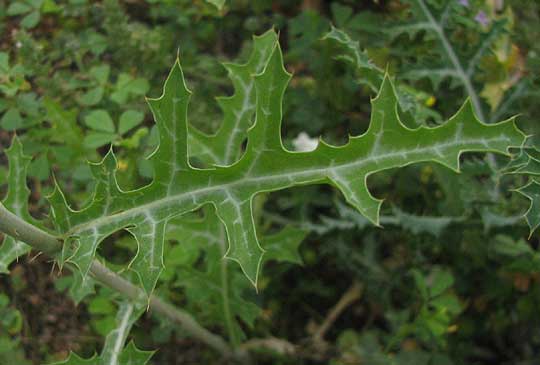
Happily, the online Flora of North America has its prickly poppy section finished, so in the prickly poppy genus key all the above field marks inexorably direct us to the Red Prickly Poppy, also known as Rose Prickly Poppy, ARGEMONE SANGUINEA.
Red Prickly Poppies are mostly found in arid northern Mexico, but their distribution area extends into the US here in southern Texas. In our area the species is described as occupying open areas, overgrazed fields, and weedy areas, but not forming solid patches like white-flowered species can. Ranchers say that livestock won't eat Red Prickly Poppies, even at the end of a long dry season when most other plants have been consumed.
Identifying Red Prickly Poppy isn't a simple matter of noticing that the plant's flowers are rosy instead of the more commonly encountered white or yellow blossoms. Red Prickly Poppy can produce white flowers, and some white-flowered species can develop reddish flowers. To get the name of a prickly poppy, flower color is important, but plant structure and form are determinative.
from the May 4, 2014 Newsletter issued from the Frio Canyon Nature Education Center in the valley of the Dry Frio River in northern Uvalde County, southwestern Texas, on the southern border of the Edwards Plateau; elevation ~1750m (~5750 ft); N29.62°, W99.86°; USA
A LESSON IN PRICKLY POPPIES
The plant featured in the above section was one of few with reddish-flowers among hundreds of other plants that were very similar, except that they bore white flowers, with many white flowers slightly rosy-tinged. During that first visit I identified only the Red Pricklypoppy, saving the white-flowered ones for later. This week I returned to the same spot in Cooks Slough on Uvalde's south side, paying attention now to the white-flowered plants. Below, you can see a typical white-flowered plant along a trail through scrubby Mesquite:
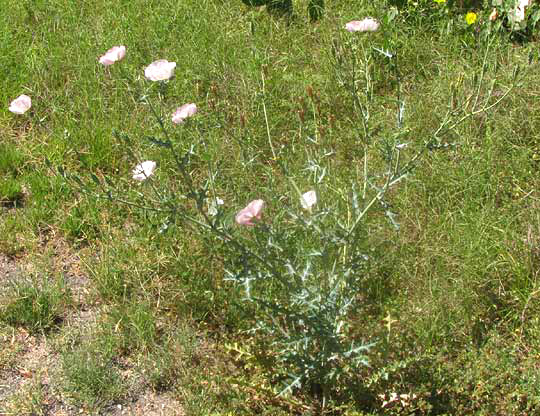
A flower close-up showing petals slightly tinged with pink and an "eye" of purplish stamens and stigmas appears below:
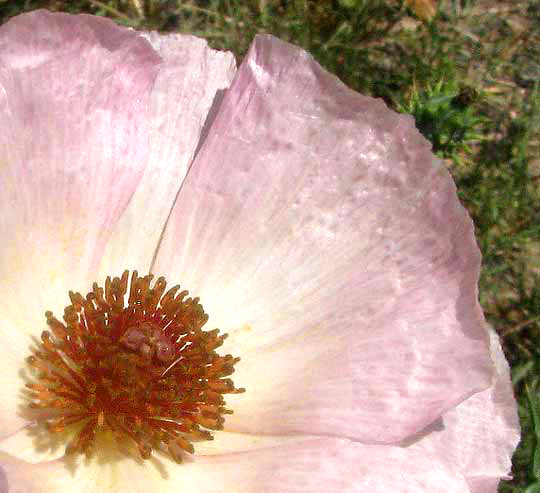
Another view showing the flower from the side, and a spiny flower bud with its spines bent slightly upward just like the Red Pricklypoppy's, is shown below:
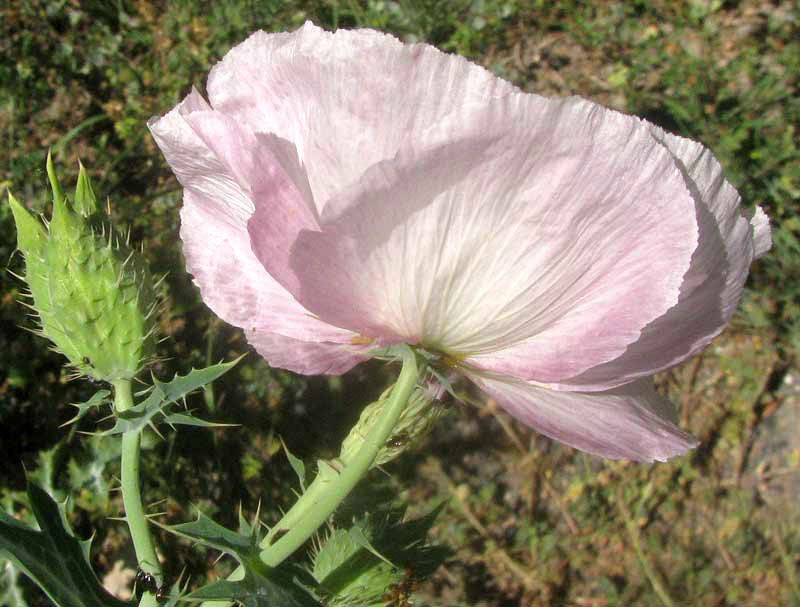
Leaves and stems on these white-flowered plants were practically identical to those of nearby Red Pricklypoppies, as you can see below:
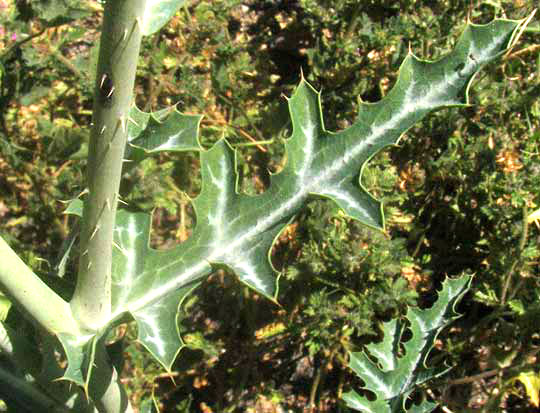
Well, probably by now you are guessing that these white-flowered plants also are Red Pricklypoppies, despite their white flowers. And despite the lack of blossoms that were neither as darkly "red" as the Red's, or brightly white as those in our photos. Well, the Flora of North America plainly describes the Red Pricklypoppy's petals as "white or lavender," so it should not have taken me so long to realize that the two flower types were all the same thing. One reason for my slowness was that on the Internet the vast majority of Red Pricklypoppies are depicted with dark lavender flowers, probably because the more vividly colored plants are easier to identify as Red Pricklypoppies.
In our area we have other white-flowered pricklypoppy species, such as the Texas Prickly Poppy so abundant in the Upper Dry Frio Valley, profiled at http://www.backyardnature.net/n/h/prickpop.htm.
The easiest way to distinguish a white-flowered Red Pricklypoppy from one of those other white-flowered species is that even in the Red Pricklypoppy's white flowers, the stamens' stem-like filaments are purplish, while filaments of other white-flowered species in our area are lemon yellow.